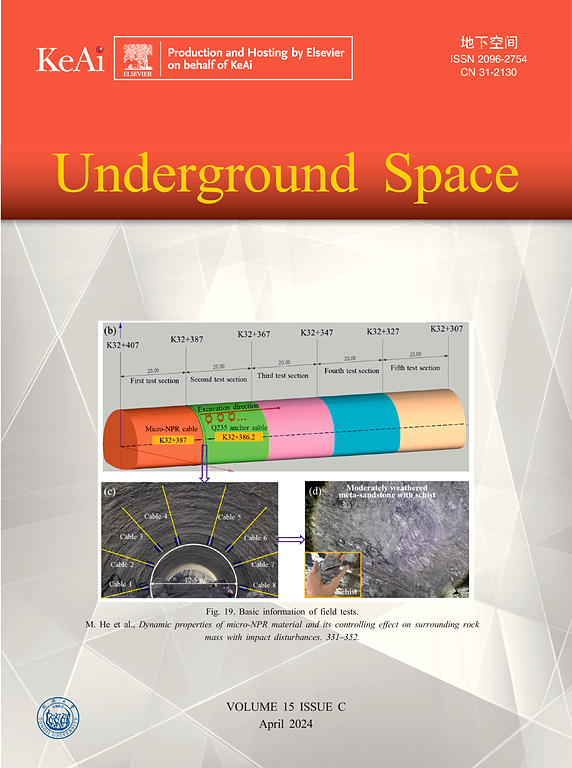自然通风竖井在多火源隧道火灾中的整体防烟性能
IF 8.3
1区 工程技术
Q1 ENGINEERING, CIVIL
引用次数: 0
摘要
本文研究了多火源情况下自然通风隧道中竖井的整体防烟性能。并与相应的单一火源情景进行了详细比较。结果表明,多个火源之间的相互作用影响了烟雾控制性能,导致烟雾层高度低于相应的单一火灾场景。对于多火源场景,随着火源中心间距的增大,火灾段烟层高度先降低后保持稳定。在总放热率相同的情况下,火灾段的烟层高度比单火源场景低20% ~ 25%。由于第一组竖井的扰动,相邻非火灾隧道段的最小烟层高度远低于火灾隧道段的最小烟层高度。对于小型隧道火灾,如汽车火灾,消防员和疏散人员的临界安全距离随着火源间距的减小而增大。对于客车火灾等大型隧道火灾,火源间距对临界安全距离的影响有限,而竖井间距则起着重要作用。火源间距和火源数量对烟蔓延长度的影响有限,因为诱导气流速度和通过竖井的总排烟率差异较小。当火源位于一个竖井以下时,完全排烟所需的竖井数最少,总烟蔓延长度最短。对于给定的火灾地点,随着竖井间距的增加,烟雾扩散长度显著增加。本研究为可能存在多火源的隧道自然通风井的设计提供了理论依据。本文章由计算机程序翻译,如有差异,请以英文原文为准。
Overall smoke control performance using naturally ventilated shafts in tunnel fires with multiple fire sources
This study investigates the overall smoke control performance using shafts in a naturally ventilated tunnel in the case of multiple fire sources. Detailed comparisons were also made with the corresponding single fire source scenarios. The results show that the interaction between multiple fire sources affects smoke control performance, resulting in a lower smoke layer height compared to the corresponding single fire scenario. For the multiple fire sources scenarios, the smoke layer height in the fire section first decreases and then keeps stable, as the fire center spacing increases. The smoke layer height in the fire section is 20%–25% lower than that in a single fire source scenario for a given total heat release rate. The minimum smoke layer height at the adjacent non-fire tunnel section is much lower than that in the fire section due to the disturbance of the first group of shafts. For a small tunnel fire such as a car fire, the critical safety distances for firefighters and evacuees increase as the fire source spacing decreases. For a large tunnel fire such as a bus fire, the effect of fire source spacing on the critical safety distance is limited, while the shaft interval plays an important role. The fire source spacing and the number of fire sources have limited influences on the smoke spread length due to the small differences in the induced air flow velocity and overall smoke exhaust rate through shafts. When the fire sources are located under one shaft, the number of shafts required for complete smoke exhaust is the least and the total smoke spread length is the shortest. For a given fire location, the smoke spread length increases significantly with an increasing shaft interval. This study contributes to the design of natural ventilation shafts in tunnels possibly with multiple fire sources.
求助全文
通过发布文献求助,成功后即可免费获取论文全文。
去求助
来源期刊

Underground Space
ENGINEERING, CIVIL-
CiteScore
10.20
自引率
14.10%
发文量
71
审稿时长
63 days
期刊介绍:
Underground Space is an open access international journal without article processing charges (APC) committed to serving as a scientific forum for researchers and practitioners in the field of underground engineering. The journal welcomes manuscripts that deal with original theories, methods, technologies, and important applications throughout the life-cycle of underground projects, including planning, design, operation and maintenance, disaster prevention, and demolition. The journal is particularly interested in manuscripts related to the latest development of smart underground engineering from the perspectives of resilience, resources saving, environmental friendliness, humanity, and artificial intelligence. The manuscripts are expected to have significant innovation and potential impact in the field of underground engineering, and should have clear association with or application in underground projects.
 求助内容:
求助内容: 应助结果提醒方式:
应助结果提醒方式:


